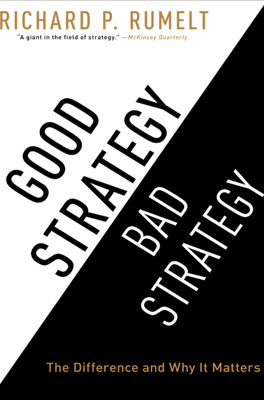Summary
Key Concepts
"Good Strategy Bad Strategy" by Richard Rumelt emphasizes the importance of clear, focused strategies over vague, aimless plans often riddled with buzzwords. The author differentiates good strategy—which leverages insightful diagnosis to inform coherent polices and actions—from bad strategy—characterized by its failure to face challenges and its reliance on goals instead of actionable plans.
Defining Good Strategy with the Kernel
The book introduces the "kernel" of good strategy, comprising:
- A Diagnosis that simplifies complexity into a clear challenge,
- A Guiding Policy for addressing the challenge,
- Coherent Actions that are strategically aligned to navigate the challenge.
Real-world examples, such as Apple’s return to profitability under Steve Jobs, illustrate the power of stripping down to basic elements and focusing efforts on core products, thereby creating surprising strategic clarity and effectiveness.
Identifying and Avoiding Bad Strategy
Rumelt discusses how common the misconception that ambitious goals are sufficient as strategy is, highlighting the hallmarks of bad strategy: misuse of lofty yet vague language (“fluff”), failure to identify real issues, and confusing targets with methods.
Strategic Reflexes in Military and Business Success
Drawing on historical examples from military contexts such as the Gulf War and business turnaround stories like that of Apple, the book shows how an unexpected, focused approach can often trump a more conventional and spread-out effort. The use of strategic leverage—anticipating and concentrating efforts where they will produce maximum effect—is crucial.
The Role of Asymmetry in Competitive Advantage
The strategic leverage of asymmetries is discussed, such as in competitive scenarios where businesses or nations use their unique strengths to create advantages that are difficult for competitors to match.
Practical Implementation: Chain-Link Systems
Rumelt expands upon how effective strategy involves the entire system of actions; akin to a chain-link system where the strength of the entire entity depends on the weakest link. Successful strategies address these systemic vulnerabilities to enhance overall performance.
Feedback Loops and Adaptation
Strategies must be adaptive as they are implemented, learning from the field, adjusting to actual conditions, and evolving through what Rumely describes as feedback loops, emphasizing that strategy is both a plan and a learning process.
In conclusion, Rumelt advocates for clarity, insight, and the coherent design of actions in strategy formulation, and warns against the dangers of superficial, disconnected, and vague strategic practices. The essence of effective strategy lies not in ambitious proclamations, but in understanding and influencing through well-defined and focused action paths. This pragmatic approach demystifies what makes a strategy truly "good" and provides readers with a blueprint to identify and rectify "bad" strategies.
Per-chapter summary
- Good Strategy Is Unexpected
- Discovering Power
- Bad Strategy
- Why So Much Bad Strategy?
- The Kernel of Good Strategy
- Using Leverage
- Proximate Objectives
- Chain-Link Systems
- Using Design
- Focus
- Growth
- Using Advantage
- Using Dynamics
- Inertia and Entropy
- Putting It Together
- The Science of Strategy
- Using Your Head
- Keeping Your Head
